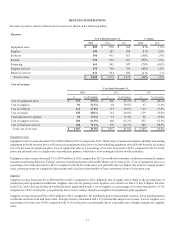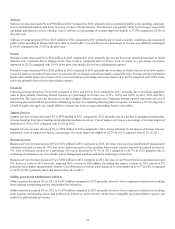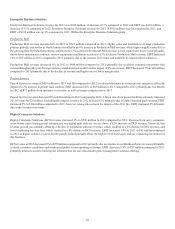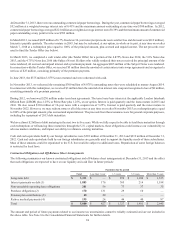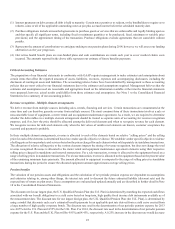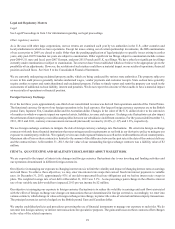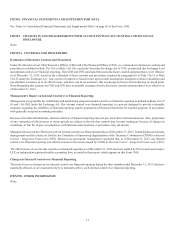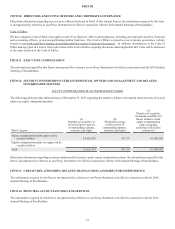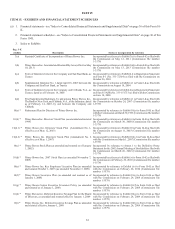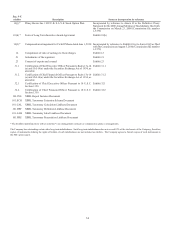Pitney Bowes 2013 Annual Report Download - page 36
Download and view the complete annual report
Please find page 36 of the 2013 Pitney Bowes annual report below. You can navigate through the pages in the report by either clicking on the pages listed below, or by using the keyword search tool below to find specific information within the annual report.25
(1) Interest payments on debt assume all debt is held to maturity. Certain notes permit us to redeem, or the bondholders to require us to
redeem, some or all of the applicable outstanding notes at par plus accrued interest before the scheduled maturity date.
(2) Purchase obligations include unrecorded agreements to purchase goods or services that are enforceable and legally binding upon us
and that specify all significant terms, including fixed or minimum quantities to be purchased; fixed, minimum or variable price
provisions; and the approximate timing of the transaction. Purchase obligations exclude agreements that are cancelable without
penalty.
(3) Represents the amount of contributions we anticipate making to our pension plans during 2014; however, we will assess our funding
alternatives as the year progresses.
(4) Our retiree health benefit plans are non-funded plans and cash contributions are made each year to cover medical claims costs
incurred. The amounts reported in the above table represent our estimate of future benefits payments.
Critical Accounting Estimates
The preparation of our financial statements in conformity with GAAP requires management to make estimates and assumptions about
certain items that affect the reported amounts of assets, liabilities, revenues, expenses and accompanying disclosures, including the
disclosure of contingent assets and liabilities. The accounting policies below have been identified by management as those accounting
policies that are most critical to our financial statements due to the estimates and assumptions required. Management believes that the
estimates and assumptions used are reasonable and appropriate based on the information available at the time the financial statements
were prepared; however, actual results could differ from those estimates and assumptions. See Note 1 to the Consolidated Financial
Statements for a summary of our accounting policies.
Revenue recognition - Multiple element arrangements
We derive revenue from multiple sources including sales, rentals, financing and services. Certain transactions are consummated at the
same time and can therefore generate revenue from multiple sources. The most common form of these transactions involves a sale or
non-cancelable lease of equipment, a meter rental and an equipment maintenance agreement. As a result, we are required to determine
whether the deliverables in a multiple element arrangement should be treated as separate units of accounting for revenue recognition
purposes, and if so, how the price should be allocated among the delivered elements and when to recognize revenue for each element.
We recognize revenue for delivered elements only when the fair values of undelivered elements are known, customer acceptance has
occurred and payment is probable.
In these multiple element arrangements, revenue is allocated to each of the elements based on relative “selling prices” and the selling
price for each of the elements is determined based on vendor specific objective evidence. We establish vendor specific objective evidence
of selling prices for our products and services based on the prices charged for each element when sold separately in standalone transactions.
The allocation of relative selling price to the various elements impacts the timing of revenue recognition, but does not change the total
revenue recognized. Revenue is allocated to the meter rental and equipment maintenance agreement elements using their respective
selling prices charged in standalone and renewal transactions. For a sale transaction, revenue is allocated to the equipment based on a
range of selling prices in standalone transactions. For a lease transaction, revenue is allocated to the equipment based on the present value
of the remaining minimum lease payments. The amount allocated to equipment is compared to the range of selling prices in standalone
transactions during the period to ensure the allocated equipment amount approximates average selling prices.
Pension benefits
The valuation of our pension assets and obligations and the calculation of net periodic pension expense are dependent on assumptions
and estimates relating to, among other things, the interest rate used to discount the future estimated liability (discount rate) and the
expected rate of return on plan assets. These assumptions are evaluated and updated annually and are described in further detail in Note
18 to the Consolidated Financial Statements.
The discount rate for our largest plan, the U.S. Qualified Pension Plan (the U.S. Plan) is determined by matching the expected cash flows
associated with our benefit obligations to a yield curve based on long-term, high quality fixed income debt instruments available as of
the measurement date. The discount rate for our largest foreign plan, the U.K. Qualified Pension Plan (the U.K. Plan), is determined by
using a model that discounts each year's estimated benefit payments by an applicable spot rate derived from a yield curve created from
a large number of high quality corporate bonds. The discount rate used in the determination of net periodic pension expense for 2013
was 4.05% for the U.S. Plan and 4.55% for the U.K. Plan. For 2014, the discount rate used in the determination of net periodic pension
expense for the U.S. Plan and the U.K. Plan will be 4.95% and 4.45%, respectively. A 0.25% increase in the discount rate would decrease




